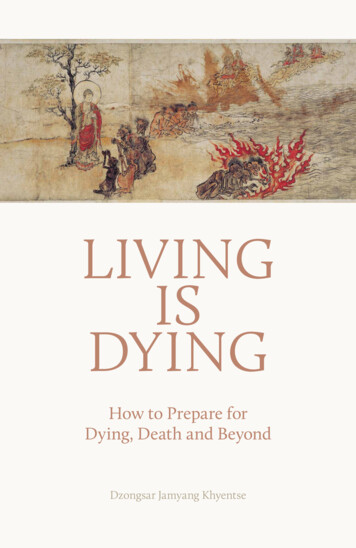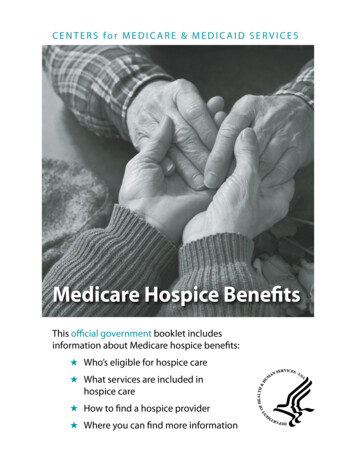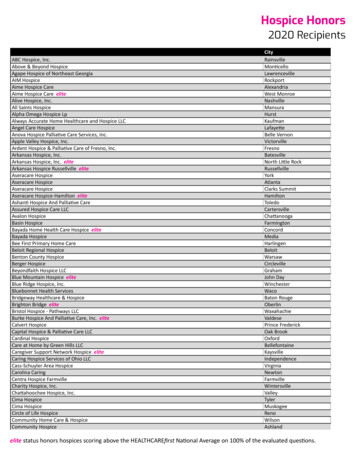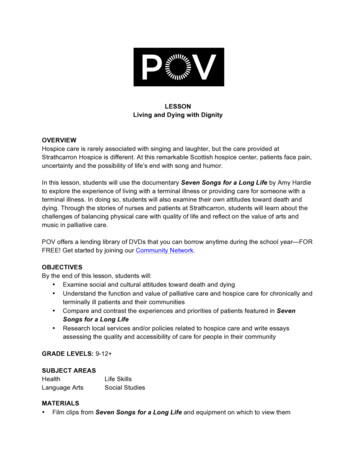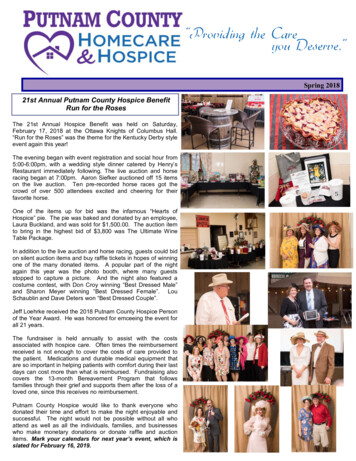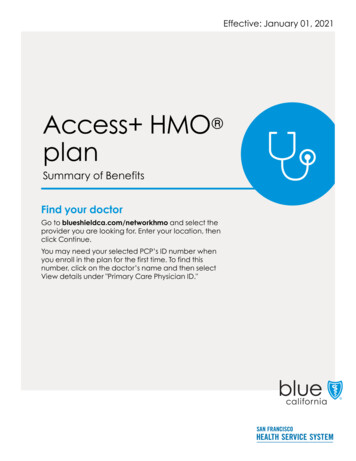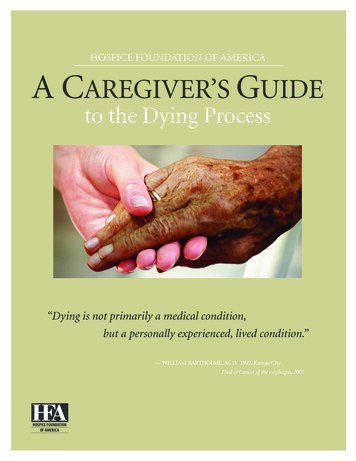
Transcription
Hospice Foundation of AmericaA caregiver’s guideto the Dying Process“Dying is not primarily a medical condition,but a personally experienced, lived condition.”— William Bartholme, M. D. 1997, Kansas CityDied of Cancer of the esophagus, 2001HOSPICE FOUNDATIONOF AMERICAHospice Foundation of AmericaA caregiver’s guide to the Dying Process1
Hospice Foundation of AmericaA caregiver’s guideto the Dying ProcessHOSPICE FOUNDATIONOF AMERICA
CONTENTSIntroduction 2Section 1: What to Expect When Someone is Dying 3The last months of life 3The final days and hours 3Section 2: What You Can Do 5Talking and listening 5Eating and drinking 6Communicating with doctors, nurses and other professionals 6Section 3: Goals of Care and Facing Tough Decisions 7Goals of care Health Care decision-making Tube feeding and intravenous or subcutaneous fluids Cardiopulmonary resuscitation Mechanical ventilation Stopping treatment aimed at curing the disease Section 4: Spiritual and Existential Concerns 778899Pain Shortness of Breath (Dyspnea) Nausea and Vomiting Bowel and bladder problems Anxiety Depression Anger Spiritual Concerns 111114141516171818Section 5: What About You — the Caregiver? Emotional Reactions Physical Reactions Support networks Spiritual or “Existential” Reactions Grief 191920202121Section 6: Resources 23–25Conclusion 26About this Booklet 26Hospice Foundation of AmericaA caregiver’s guide to the Dying Process1
INTRODUCTIONA Caregiver’s Guide to the Dying Process is intendedfor anyone who is caring for a person near theend of life. Our goal is to help make your experience as meaningful and manageable as possible.Many who are caring for a terminally ill personhave never done so before. You may feel frightened, confused, and overwhelmed. It is hard toknow and accept that someone we care for is nearthe end of life. Caregiving is difficult, but it canalso be rewarding. Caregivers tell us that they areboth exhausted and uplifted by the task of caringfor someone near the end of life, and when itis over, most of them say they are grateful theycould do it.Topics Covered in This BookletA Caregiver’s Guideto the Dying ProcessFor each person and each caregiver, the path through endof life to death is different. With this booklet, HospiceFoundation of America hopes to provide you, the caregiver, with knowledge and understanding to guide youthrough caring for your terminally ill loved one.The booklet is divided into 6 sections. In the first section,we provide an overview of the physical, emotional,psychological and spiritual changes that are often seen inthe last months or year of life. We also describe commonchanges in the final days and hours prior to death.In the second section, we discuss what you, the caregiver, cando to ease physical and emotional discomfort. In addition,we offer suggestions for how you can communicate effectively with health care professionals.In the third section, we introduce ideas about the changinggoals of care as a person approaches the end of life. Wealso discuss some of the difficult health care decisions thatarise and offer information that may help you thinkthrough these issues.00Descriptions of the physical, emotional andspiritual changes occurring near the end of life,to help you understand what is happening;00Suggestions for what you, as the caregiver, can doto ease physical and emotional distress and makethe dying person as comfortable as possible;00Information to help you, as the caregiver,communicate effectively with doctors, nursesand other healthcare professionals; andThe fifth section is about you, the caregiver. We discusswhat you may experience as your loved one approachesdeath, and suggest ways to take care of yourself.Reflections on how you might feel as thecaregiver for someone who is dying and ideasfor how to care for yourself.In the sixth and last section, we list resources such as booksand websites where you can find additional information.00In the fourth section, we provide more detail on specificsymptoms — physical and emotional — common nearthe end of life. We describe each symptom and commontreatments, and suggest when you may want to call onprofessionals to help.SECTION 1:As you care for a dying loved one, understanding the physical and emotional changes that occur during illness anddeath will help you provide meaningful and effective support. In this section, we present a general description of whatyou might expect to happen physically and emotionally.For more detailed information about specific symptomsand how they can be managed, turn to Section 4.The last months of lifeIn the last 6 to 12 months before death, people with a progressive, debilitating disease commonly experience certainphysical symptoms. Many people, as they approach theend of life, will become less active and experience chronicfatigue or weakness. Weight loss and diminished appetiteare also common. Many people experience increasing painwhich may be diffuse or in specific areas. Other commonphysical symptoms include shortness of breath, eventhough they are moving little, or tingling in the hands andfeet usually due to disordered nerve function. All of thesetogether generate increasing physical discomfort.If your loved one has an advanced disease, these and otherphysical symptoms specific to the illness may be pronounced.In addition, skin may become thin and begin to break down,causing irritation or open sores. “Bed sores” may form whenthe person sits or lies down most of the day without changing position. As time goes by, many people lose the ability tocontrol their bladder or bowels. This is often distressing forboth the dying person and the caregiver.In the final 6 to 12 months of life, people often go throughemotional changes as well. Caregivers who understand thiscan help relieve the worries and stresses of the person whois dying.As the reality of approaching death sets in, people tend toexperience a variety of emotions ranging from anger, anxiety,2A caregiver’s guide to the Dying ProcessHospice Foundation of AmericaHospice Foundation of AmericaWhat to Expect WhenSomeone is Dyingor depression to feelings of acceptance and contentment.They may become less interested in the world around themand withdraw into themselves. Sometimes this is due tosadness and a sense of loss, but it may also be a healthy wayof preparing to leave their world. Many people fear becoming aburden on loved ones and may feel guilty or resentful. Whileit is common for people nearing the end of life to be moody,dying may be a time of revelation and profound change.In addition to physical and emotional changes, manypeople near the end of life begin thinking about the meaningand purpose of life in general, and of their life in particular.They often think about how they have lived and who theyare, resulting in feelings of either contentment or discomfort. For many, there is sense of heightened spirituality. Theymay feel closer than ever to a “supreme being” or “spiritualpower,” or they may feel rejected by this entity. Somepeople find religious meaning in the physical sufferingthat can accompany dying and may feel that suffering onearth is rewarded in the afterlife.The final days and hoursAll dying experiences are unique and influenced by manyfactors, such as the particular illness and the types of medications being taken, but there are some physical changesthat are fairly common. For some, this process may takeweeks; for others, only a few days or hours.For most dying persons, activity decreases significantly in thefinal days and hours of life. They speak and move less andmay not respond to questions or show little interest in theirsurroundings. They have little, if any, desire to eat or drink.As you hold their hand, you may notice that they feel cold.When a person is dying his or her body temperature can godown by a degree or more. Blood pressure will also gradually lower and blood flow to the hands and feet will decrease.A caregiver’s guide to the Dying Process3
When a person is just hours from death, breathing oftenchanges from a normal rate and rhythm to a new pattern ofseveral rapid breaths followed by a period of no breathing.This is known as “Cheyne-Stokes” breathing — namedfor the person who first described it. Coughing can alsobe common as the body’s fluids begin to build up inthe pharynx. Fluid that accumulates in the pharynx alsocauses “rales” and “rattles.” This breathing sound is oftendistressing to caregivers, but it is not an indication of painor suffering. The secretions that cause these sounds can bedried up with a medication called atropine, typicallyadministered orally, or with a small dose of liquid morphine.The oral administration of a small amount of a commoneye drop solution usually prescribed to reduce the amountof tears can also help reduce the amount of fluid buildup.On the other hand, when secretions are thick or dry, running a vaporizer in the room can ease breathing.As death approaches, skin color is likely to change from itsnormal tone to a duller, darker hue. The fingernail bedsmay also become bluish rather than their normal hue.Another type of misperception is hallucination. Dyingpersons may hear voices that you cannot hear, see thingsthat you cannot see, or feel things that you are unableto touch or feel. They may also have visions of deceasedrelatives, which may be haunting to the dying person or toyou the caregiver, but it is a common occurrence.Some dying persons confuse reality and might thinkthat others are trying to hurt them or cause them harm.Or, they can come to believe that they are much morepowerful than they really are and think that they canaccomplish things that are not possible. These types ofmisconceptions are called delusions of persecution anddelusions of grandeur.If you want more information about the sequence ofevents leading up to the moment of death, we suggest thebook How We Die by Sherwin Nuland, M.D. (New York:Knopf, 1993.)Because family members and other caregivers may not feelprepared to handle the events and changes that occur nearlife’s end, we offer the following suggestions from hospicephysicians, nurses, social workers, chaplains and aideswith many years of experience caring for dying people. Inmost cases, health care professionals will be responsiblefor treating the physical symptoms associated with seriousillness toward the end of life. (In Section 4, we will explainthe treatments for common symptoms.) But you, thecaregiver, will be complementing the care of professionalswith personal attention and support.and what it means to have only a short time to live. Justtalking about what they are thinking, feeling, and needingcan be very comforting. Dying people oftentimes want totell their story, to remind themselves and others of whothey are and what they value in their life. They may needtime to reflect on and to grieve past and present losses aswell as explore their mortality and spirituality.00Talking and listening00Assistance with eating and drinking00Communicating with physicians and otherhealth care professionalsIn this section, we focus not on specific symptoms, butrather on general types of support that tend to fall on you,the non-professional caregiver. We are not suggesting thatthis is all that can be done, or that all of our suggestionsare appropriate in your particular case. Every situationis different and we can only offer advice based on collective experience. We hope the ideas presented here fromexperienced caregivers will help you think about how youcan best care for your loved one.It is not unusual for dying persons to experience sensorychanges. Sometimes they misperceive a sound or getconfused about some physical object in the room. Theymight hear the wind blow but think someone is crying orsee a lamp in the corner and think that someone isstanding there. These types of misperceptions are calledillusions. They are misunderstandings about somethingthat is actually in their surroundings.A caregiver’s guide to the Dying ProcessWhat Can You Do?General types of support providedby caregiversBecause the central nervous system is directly impacted bythe dying process, your loved one may sometimes be fullyawake and other times not responsive. Often before death,people will lapse into a coma. A coma is a deep state ofunconsciousness from which a person cannot be aroused.Persons in a coma may still hear what is said even whenthey no longer respond. They may also feel somethingthat could cause them pain, but not respond outwardly.Caregivers, family, and physicians should always act as ifthe dying person is aware of what is going on and is able tohear and understand voices. In fact, hearing is one of thelast senses to lapse before death.4SECTION 2:Talking and listeningAs the end of life approaches, you can assure your lovedone that they will be cared for and will not be abandoned.You can provide them with the opportunity to talk abouttheir wishes and concerns or their reflections on the illnessHospice Foundation of AmericaHospice Foundation of AmericaYou can talk with them about how they want to be caredfor when the end is near. Some people will want to stayat home and “die in their own bed;” others will want tobe in a hospital or other health care facility where healthcare professionals are at hand. They may want to have allthe family close by, or they may prefer to be with just oneor two people. They may want to hear soothing music orhave favorite photos or mementos close by. Or, they maynot have any specific preferences.You can make sure that documents like a power of attorneyfor health care, a health care surrogate designation, and/or a living will are completed and available to health careproviders. Perhaps one of the most meaningful advancedirectives is called “5 Wishes,” which is completed by thedying person and then given to the physician or team ofhealth care providers. Additionally, something known as aPOLST or Physicians Orders for Life Sustaining Treatmentis a growing trend. This document is typically discussedand signed by both the patient and physician; however itis not yet legally binding in all 50 states. These proceduresassure that end-of-life wishes are documented so they canbe carried out.You can offer to contact people they care about so thatthey can say goodbye. Spending time with selected familyand friends may be some of the most valued moments asdeath approaches. Ira Byock, MD, in his book The FourThings that Matter Most (New York: Free Press, 2004)offers stories about the role of interpersonal relationshipsA caregiver’s guide to the Dying Process5
near the end of life. In his work with the dying, he haslearned that most people want the chance to say one ormore of four things to people who have been importantto them: “Please forgive me,” “I forgive you,” “Thank you,”and “I love you.” In some cases, people near the end of lifealso need to express dissatisfaction, anger, or resentmentin order to feel at peace.As death approaches, you can help your loved one toattend to unfinished business and take care of financialresponsibilities. It is important to many dying persons todecide who will receive their personal possessions, andthey may want to create or update their will. You can askthem about their preferences for funeral arrangementsand talk to them about their concerns regarding the lovedones they are leaving behind. When young children aresurviving the dying person, they need particular attention.It may be best to speak with a professional, such as a socialworker, psychologist, child life specialist or art therapist,who knows how to talk with children at different agesabout death and dying. And, you may want to speak withfinancial consultants who can help set up trusts to assurethat young children are protected financially.Eating and drinkingYou may be wondering why there is a section on food anddrink in this booklet. Eating and drinking are importantparts of most cultures and are a way we relate to eachother, particularly within families. One of the mostimportant ways we care for each other is through offeringfood and drink.As mentioned earlier, people who are in the last year oflife often lose their appetite; food stops tasting good andthey do not want to eat. Sometimes they can be temptedwith favorite foods, or what we call “comfort foods.” But atsome point they will simply not be able to eat. This is hardon caregivers who want to provide nourishment, and whomay feel that their loved one would live longer if only theywould eat more.When appetite begins to fail, you as the caregiver can andshould offer a variety of foods. Talk to your loved oneabout what they think would taste good and let them6A caregiver’s guide to the Dying Processknow it is acceptable not to have a full meal. They may notwant “usual foods” at “usual times.” Ask the doctor if thereare any foods that should be avoided. For those who havebeen on restricted diets, ask the doctor if they can nowhave favorite foods. Foods previously avoided for healthreasons may now be acceptable and could improve anotherwise declining outlook. Offer small portions and donot force them to eat. Make sure water or other drinks areavailable and remind them to drink, as they may not feelthirsty. Dry mouth is uncomfortable but can be counteracted by applying sponges dipped in the patient’s favoriteliquid. Remember that there are many ways to show youcare that do not involve food and drink.Sometimes, people with serious life-threatening illness willmake a specific choice to stop eating or drinking; this isdifferent from the natural decrease in appetite discussedabove. If this happens, you will want to consult a physicianwho may suggest counseling. It is important to be surethat any decisions made are well-considered and not theresult of treatable depression or anxiety. (More informationon these symptoms appears in Section 4.)Communicating with doctors, nursesand other professionalsIn your role as caregiver, you may be dealing with physicians and nurses on behalf of another adult for the firsttime. And you may be the only person, other than yourloved one, who knows all of the different health careprofessionals who are providing care. You can help bymaking sure that all of the doctors and nurses know whatyour loved one wants and that they know which otherhealth care providers are involved.Different people want and need different levels of informationfrom health care professionals and everyone deserves toreceive information in ways they can understand. Tell thedoctors and nurses how much you want to know and ask forfurther information if you do not understand what theytell you. Take notes or ask them to write things down for youso you can remember them and review them at any time.Make sure that the doctors and nurses know how involvedyou and your loved one want to be in making treatmentHospice Foundation of Americadecisions. Most people want to discuss all the options withthe doctor or nurse and then make a decision that all canagree on; but some people want the doctor to decide whatis best.one are the experts on your needs and preferences. Youcan work as an effective team with health care professionals to assure that your loved one receives treatment thatrelieves symptoms, helps maintain dignity and quality oflife, and honors his or her goals of care.Although doctors and nurses have medical knowledge thatyou as a non-professional do not have, you and your lovedSECTION 3:Difficult decisions near the end of life00Artificial nutrition and hydration – Whetheror not to have tube feeding and/or intravenousfluids00Cardiopulmonary resuscitation – Whether ornot to restart the heart if it stops beating00Mechanical ventilation (Intubation) – Whetheror not to use machine to breath for a personwhose lungs have stopped working00Stopping treatment aimed at curing the diseaseGoals of careWhen health first begins to fail, because of a specific illnessor generalized decline, most people hope for a cure. Theyhope to be returned to better health and freedom fromillness. But even as that hope fades, there is much to hopefor. People can hope and expect to have their pain anddiscomfort acknowledged and treated effectively. They canhope for and expect to be involved in activities they enjoy,though perhaps in different ways. And people have theright to hope for a miracle and to seek aggressive treatmentthat others may think is futile.Hospice Foundation of AmericaGoals of Care and FacingTough DecisionsFor most people, the goals of care will shift as patientsdecline or as illness progresses and cure seems less likely.Although efforts to modify and treat the disease maycontinue, the primary focus will be on maintainingcomfort, supporting as much physical functioning aspossible, and maintaining quality of life.Health Care decision makingFour of the most common but distressing health caredecisions near the end of life are: whether to provide tubefeeding; whether to use electric shock and/or CPR(cardiopulmonary resuscitation) to restart a heart thathas stopped working; whether to use a machine tobreathe for someone whose lungs have stopped working;and whether to stop treatments aimed at curing disease.The decision to forego life support is a very personal one.It is frequently influenced by cultural and religious beliefs.Hopefully, you and your loved can talk about these issuesin advance of the need for any of these types of artificialsupport. In this section, we will describe these proceduresand some of the pros and cons of each, to help you makeinformed decisions.A caregiver’s guide to the Dying Process7
Tube feeding and intravenous orsubcutaneous fluidsOne difficult decision you may confront as a caregiver iswhether to provide your loved one with artificial nutrition (tube feeding), or liquids delivered via a needle intothe bloodstream (intravenous or subcutaneous fluids.)Artificial nutrition and hydration may supplement orreplace ordinary eating and drinking by giving a chemically balanced mix of nutrients and fluids through a tubeplaced directly into the stomach, the upper intestine, or avein. Short-term artificial nutrition and hydration can savelives in cases where a person has a curable illness, has suffered an accident, or is recovering from surgery and needshelp to take in nutrition until the body heals. Long-termartificial nutrition and hydration may be given to peoplewith serious intestinal disorders that impair their ability todigest food, thereby helping them to enjoy a quality of lifethat is important to them.The use of tube feeding has pros and cons, however, whenused for people with end-stage conditions. Nutritionaltreatment may help to keep up energy levels if the personotherwise is feeling well or wants to be able to participatein a specific event — like a wedding or a holiday celebration. But nutritional treatment will not reverse the courseof the disease itself. For individuals who have troubleswallowing, as often happens with Alzheimer’s diseaseor other dementias, tube feeding may increase the risk ofpneumonia because the liquid food may unintentionallyget into the lungs.Similarly, artificial hydration has pros and cons. Forpeople who cannot swallow or who cannot “keep anythingdown,” but have otherwise good organ function, intravenous delivery of fluids can be essential to maintainingthe function of the brain and other critical organs. But forpeople whose organs are not functioning well, particularlythose who are having heart, lung and/or kidney problems,delivery of intravenous liquids can put more strain onthese organs causing even more difficulty.You may be worried that not eating or drinking wouldcause discomfort, but studies show that for persons in thefinal phase of illness, going without food and fluids is notpainful. The fact is that people at the end of life who have8A caregiver’s guide to the Dying Processstopped eating and drinking naturally, or by choice, do notcomplain of thirst or hunger. In fact, there is a side effectof going without food and fluids in which metabolismchanges produce a mild sense of euphoria and calm.For people who are not eating or drinking, it is standardcare to apply moisture in some form to the lips and mouthregardless of whether or not the dying person is ever ableto swallow again. You can use a moistened cloth or swab.In fact, application of moisture to the lips is comfortingeven for people who are able to drink fluids.Some religious traditions require that people not bedenied food and drink, so artificial nutrition and hydration may be important from a religious perspective foryour loved one or for you. A decision to start or stop tubefeeding or intravenous fluids should be discussed withyour loved one whenever possible, so that their wishes canbe expressed and honored. The decision should also bediscussed with family and health care professionals so thatyou can be as comfortable as possible with the decision.The patient’s goals of care should come first in all discussions on the benefits and burdens of tube feeding.Cardiopulmonary resuscitationCardiopulmonary resuscitation (CPR) is a group of treatments used when someone’s heart and/or breathing stops.CPR is used in an attempt to restart the heart and breathing.It may consist only of mouth-to-mouth breathing or it caninclude pressing hard on the chest to massage the heartmuscle and cause blood to circulate. Electric shock anddrugs are also used frequently to stimulate the heart. Mostpeople have seen some form of cardiopulmonary resuscitation acted out on television or in movies.The fact is that CPR can be successful for healthy peoplewhose heart and lungs have stopped due to a severe injuryor other trauma. These are people whose heart and lungsare not damaged by illness or old age. But the success ratefor CPR when used for people who are at the end of aterminal disease is extremely low. In these cases, the heartand lungs usually stop because of irreversible progression of the disease. Even though the heart can possibly berestarted, it is likely to fail again soon. Another thing toconsider is that the CPR process, which includes strongHospice Foundation of Americacompression of the chest, can be painful and may damagefragile bones and internal organs.The decision to allow CPR should follow a thoroughdiscussion of the patient’s goals. If you and your loved onedecide that you do not want CPR, it is important to let thedoctor and other health care professionals know aboutthis choice. This information is usually included in a livingwill or other advance directive document, but even if thedocuments are completed, it is important to talk to healthcare providers about this and other decisions and choices.If your loved one is in the hospital and does not wish toreceive CPR, the doctor must write a “do-not-resuscitateorder,” called a DNR. In many states, the doctor can alsowrite this order for a person being cared for at home or ina nursing home, and it will be honored by paramedics orother emergency medical personnel. Ask your doctor howto be sure that your loved one’s wishes will be honored.Mechanical ventilationMechanical ventilation is used to support or replace thefunction of the lungs. A machine called a ventilator (orrespirator) forces air into the lungs. The ventilator isattached to a tube inserted in the nose or mouth anddown into the windpipe (or trachea). For many people,mechanical ventilation can be life restoring. It is verysuccessful when used to assist a person through a shortterm health problem. It is also useful for prolongedperiods for people with irreversible respiratory failure dueto a progressive neurological disease or injuries to theupper spinal cord.For the dying person, however, mechanical ventilationoften merely prolongs the dying process until some otherbody system fails. It may supply oxygen, but it cannotimprove the underlying condition. Important questions toask if mechanical ventilation is suggested include:00How long will your loved one be connected to theventilator?00Is this a temporary measure to allow the lungs or otherorgans to heal?00What is this experience like?Hospice Foundation of America00How likely is it that your loved one will ever regain theability to breathe on his or her own and return to anacceptable quality of life?If possible, you and your loved one will want to talk aboutyour preferences for or against mechanical ventilationbefore the decision has to be made. As with CPR, if youand your loved one decide not to have mechanical ventilation, you can ask the doctor to write a “do not intubate”order. Whatever you decide, be sure to share the information with all of the health care providers serving yourloved one.Stopping treatment aimed at curing the diseaseIt is always hard to accept the idea that someone we lovewill die, or that we ourselves will die.
or a living will are completed and available to health care providers. perhaps one of the most meaningful advance directives is called “5 Wishes,” which is completed by the dying person and then given to the physician or team of health care providers. additionally, something known as a

